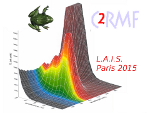N.R. JANKOWSKI1, I.K. BAILIFF1 AND L.M. SNAPE-KENNEDY1
1Department of Archaeology, Durham University, South Road, Durham DH1 3LE
Access to water resources was vital for the survival of ancient peoples inhabiting arid landscapes. In such regions, surface water quickly becomes unavailable through evaporation or infiltration into the subsurface. To gain access to the subterranean water supply required new and innovative techniques. One example of this innovation was the development of the qanat. The qanat (also known as Foggara, Falaj, Khettara, Kariz, and many other names) is effectively a water tunnel dug horizontally into the subsurface towards a vertical, water-producing well located in the hinterland that is used to conduct water towards the plains for agriculture and subsistence. Vertical access shafts are dug at regular intervals along the tunnel to both remove the excavated material and provide access during routine maintenance. The material removed from the qanat via the vertical shafts is piled onto the ground surface surrounding the opening to form a mound resembling a ring, and often referred to as a ‘doughnut'.
The dating of the construction of qanat systems, however, is problematic. Although in some instances, historical documentation or association with nearby settlements may help shed light on the age of construction, the frequent absence of suitable organic materials associated with the formation of the mounds has led to a general absence of the testing of the chronology of qanat systems using absolute dating methods. However, recent work conducted on a site in northern Spain (Bailiff et al., 2015) has successfully demonstrated the potential of OSL applied in conjunction with micromorphological analysis to investigate the chronostratigraphy of qanat shaft mounds. Similar work in Iran (Fattahi, 2015) has also underlined the importance of finding minerals with favourable optical bleaching characteristics and the complexities that arise when this is not the case. Given the nature of the deposition of sediments that form the mounds, the generally more rapid optical bleaching characteristics of quartz OSL compared with that of feldspars is a significant advantage. Hence a detailed assessment of the luminescence characteristics of the mineral suite available within the shaft mound deposits at a single grain level is of particular importance.
This paper presents the preliminary results of the assessment procedure applied to a qanat system in southern of Morocco. Basic mineral composition and luminescence sensitivities from coarse grains were assessed using an OSL laser-scanning system (Bailiff and Mikhailik, 2003), with both untreated and HF-etched separates. A measure of the overdispersion of equivalent dose values was obtained by applying a SAR procedure to small single aliquots, together with the application of a bright grain count procedure. Soil micromorphological examination of block samples taken from the mounds will also be applied to evaluate sediment structure and composition to reconstruct the site formation processes. Combined, these two approaches will allow the OSL age determinations to be placed within their proper sedimentological context.
References
Bailiff, I.K., Gerrard, C.M., Gutiérrez, A., Snape-Kennedy, L.M. and Wilkinson, K., 2015. Luminescence dating of irrigation systems: Application to a qanat in Aragón, Spain. Quaternary Geochronology.
Bailiff, I.K. , Mikhailik, V.B., 2003. Spatially-resolved measurement of optically stimulated luminescence and time-resolved luminescence. Radiation Measurements, 37, 151-159.
Fattahi, M., 2015. OSL dating of the Miam Qanat (Kariz) system in NE Iran. Journal of Archaeological Science. In press.

 PDF version
PDF version
